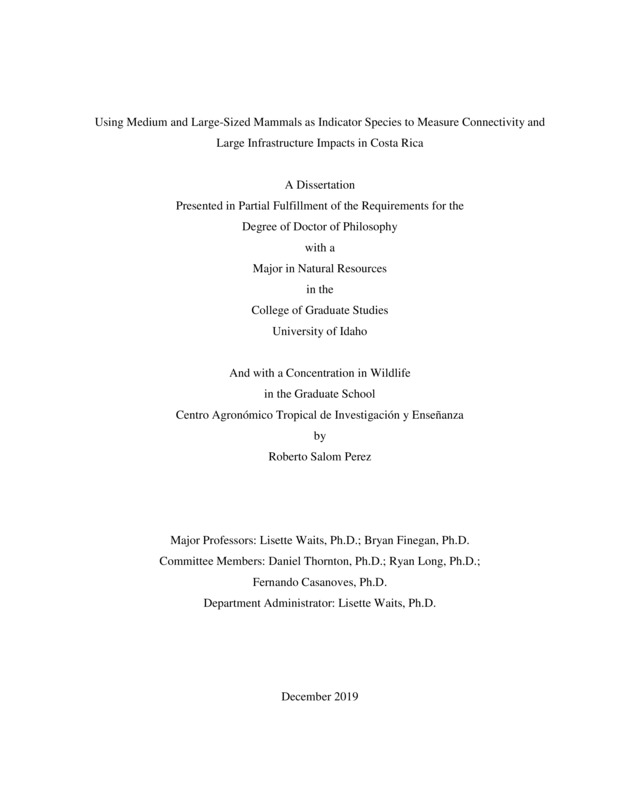Using Medium and Large-Sized Mammals as Indicator Species to Measure Connectivity and Large Infrastructure Impacts in Costa Rica
Salom Perez, Roberto Salom. (2019-12). Using Medium and Large-Sized Mammals as Indicator Species to Measure Connectivity and Large Infrastructure Impacts in Costa Rica. Theses and Dissertations Collection, University of Idaho Library Digital Collections. https://www.lib.uidaho.edu/digital/etd/items/salomperez_idaho_0089e_11719.html
- Title:
- Using Medium and Large-Sized Mammals as Indicator Species to Measure Connectivity and Large Infrastructure Impacts in Costa Rica
- Author:
- Salom Perez, Roberto Salom
- ORCID:
- https://orcid.org/0000-0003-3404-9585
- Date:
- 2019-12
- Keywords:
- Biological corridors Genetic diversity Infrastructure impacts Leopardus pardalis Occupancy models Panthera onca
- Program:
- Natural Resources
- Subject Category:
- Wildlife conservation
- Abstract:
-
Conservation of biodiversity in all its forms, genetics, species and ecosystems, is essential to maintain the resilience of ecosystems and the stability of their functions and services. Over the past two centuries ecosystems are being changed, mainly associated to human-related impacts, global forest cover is being lost at a rate of 0.6% per year and extinction of species are occurring at a much higher rate than in most previous periods. Additionally, many protected areas are not enough to guarantee the long-term survival of species that require large extents to sustain viable populations. Thus, connectivity between protected or natural areas through dispersal or biological corridors is crucial for the conservation of wide-ranging species and biodiversity in general.
Moreover, low genetic diversity and reduced gene flow may decrease the ability of a species to survive by reducing its ability to adapt to environmental changes or human-related threats, decreasing fitness and increasing genetic drift. Therefore, measuring genetic diversity and population structure is vital to quantify biodiversity at an evolutionary significant unit (i.e. populations with high genetic or ecological distinction) level.
Medium and large-sized mammals play an important role in the ecosystems where they occur, but are also subject to several threats. Given, their high habitat requirements in terms of food and extent of area some medium and large-sized mammals are at higher risk of extinction than other species. This makes them especially vulnerable to habitat alterations and human related pressures. Consequently, medium and large-sized mammals can be monitored and used as indicator species to test for connectivity between protected or core areas, and assess the impacts of human activities (e.g. large infrastructure projects) on wildlife.
This research intended to use medium and large-sized mammals to evaluate the condition of a critical link of the Mesoamerican Biological Corridor (MBC) in Costa Rica. Also, we intended to measure the impacts of a hydroelectric reservoir on the mammal community in this corridor. Rather than using single species analyses, we used hierarchical community occupancy models in a Bayesian framework. This, not only allowed for the use of data of rare species, but we believed helped produce stronger inferences on the status of the landscape in terms of biodiversity. Our results suggest that the status of this critical link with respect to medium and large-sized mammals is precarious.
Furthermore, we were able to measure the impacts of the reservoir on medium and large mammals’ occupancy by including a dynamic component and comparing results in three time periods: before the flooding of the reservoir, immediately after the completion of the flooding of the reservoir, and approximately one year after the flooding of the reservoir. We found considerable changes in medium and large-sized mammals’ occupancy before and after the filling of the reservoir.
In this work we also evaluated genetic diversity and population structure of ocelots (Leopardus pardalis) Costa Rica, and compared the genetic diversity of Costa Rican ocelots with that of jaguars (Panthera onca) and pumas (Puma concolor) in the country, and with ocelots in Belize. We found relatively high levels of genetic diversity for ocelots in Costa Rica and no patterns of genetic substructure, suggesting high levels of gene flow throughout the country and no strong barriers to movement. Additionally, genetic diversity of Costa Rican ocelots was higher than that of jaguars and pumas, and levels of genetic diversity were slightly higher in Costa Rican ocelots when compared to their counterparts in Belize, confirming the south to north decrease in genetic diversity reported in other studies for the species.
We believe the community approaches implemented here can be used to monitor biodiversity and measure the effects of infrastructure in general on wildlife, help avoid impacts, and plan proper mitigation actions. Our study also provides critical baseline information to understand what is the status of the ocelot populations in the country.
- Description:
- doctoral, Ph.D., Natural Resources -- University of Idaho - College of Graduate Studies, 2019-12
- Major Professor:
- Waits, Lisette P; Finegan, Bryan
- Committee:
- Thornton, Daniel ; Long, Ryan ; Casanoves, Fernando
- Defense Date:
- 2019-12
- Identifier:
- SalomPerez_idaho_0089E_11719
- Type:
- Text
- Format Original:
- Format:
- application/pdf
- Rights:
- In Copyright - Educational Use Permitted. For more information, please contact University of Idaho Library Special Collections and Archives Department at libspec@uidaho.edu.
- Standardized Rights:
- http://rightsstatements.org/vocab/InC-EDU/1.0/

